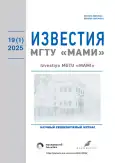Trends in the development of modern electric motors: challenges, difficulties and results
- Authors: Zherdev P.I.1, Biksaleev R.S.1, Karpukhin K.E.1
-
Affiliations:
- Central Scientific and Research Automobile and Automotive Engines Institute NAMI
- Issue: Vol 19, No 1 (2025)
- Pages: 422-429
- Section: Electrotechnical facilities and systems
- URL: https://journal-vniispk.ru/2074-0530/article/view/311268
- DOI: https://doi.org/10.17816/2074-0530-676821
- EDN: https://elibrary.ru/TPXHSY
- ID: 311268
Cite item
Full Text
Abstract
Background: The future of the industry is tied to the adoption of innovative materials and technologies, as well as reducing reliance on rare-earth elements. It is essential to assess current trends to address challenges such as the shortage of rare-earth materials, stringent energy efficiency requirements, and constraints on the weight and size of electric machines in electrified vehicles.
Aim: Analysis of trends in modern engineering technologies and practices that allow reducing production costs and enhancing the energy efficiency of electric motors.
Methods: The research methodology is based on a systematic literature review, qualitative analysis, and meta-analysis of the available data.
Results: Scientific works were analyzed to identify key trends in the development of modern traction electric motors. An expert-analytical assessment of approaches and optimal methods for cost reducing in the production of electric motors for electrified vehicles is proposed.
Conclusion: The prospects of electric motors evolution are related to the implementation of innovative materials and technology. The growing development and adoption of axial flux machines demonstrate significant progress in the industry. However, further research is needed to overcome existing limitations, including the shortage of rare-earth materials and constraints related to motor size and weight.
Full Text
##article.viewOnOriginalSite##About the authors
Pavel I. Zherdev
Central Scientific and Research Automobile and Automotive Engines Institute NAMI
Author for correspondence.
Email: pavel.zherdev@nami.ru
ORCID iD: 0009-0004-1002-0256
SPIN-code: 2857-7951
1st grade design engineer of the Electronic Devices Center
Russian Federation, MoscowRinat Sh. Biksaleev
Central Scientific and Research Automobile and Automotive Engines Institute NAMI
Email: rinat.biksaleev@nami.ru
ORCID iD: 0009-0004-0199-9394
SPIN-code: 5186-4044
Cand. Sci. (Engineering), lead engineer of the Scientific and Educational Center
Russian Federation, MoscowKirill E. Karpukhin
Central Scientific and Research Automobile and Automotive Engines Institute NAMI
Email: kirill.karpukhin@nami.ru
ORCID iD: 0000-0002-6192-7817
SPIN-code: 8926-2694
Cand. Sci. (Engineering), Assistant Professor, Project Director of the Project Management Center
Russian Federation, MoscowReferences
- Tuan NKh, Karpukhin KE, Terenchenko AS, Kolbasov AF. World Trends in the Development of Vehicles with Alternative Energy Sources. ARPN Journal of engineering and applied sciences. 2018;13(7):2535–2542. CODEN: JEASHK
- Terenchenko AS, Karpukhin KE, Shorin AA, Sklyarinskiy SF. Optimization of losses in traction asynchronous motor as a part of combined power plant. Scientific, technical and industrial journal «Vestnik Mashinostroeniya». 2014:12–14. (In Russ.) EDN: UYZOVP
- Leonard TC. Principles of Electric Machines and Power Electronics. 3rd ed. Hoboken: Wiley; 2014. 672 p.
- Mom G. The Electric Vehicle: Technology and Expectations in the Automobile Age. Baltimore: Johns Hopkins University Press; 2004. 416 p.
- Mom G. The Electric Vehicle: Technology and Expectations in the Automobile Age. New Brunswick: Rutgers University Press; 2000. 320 p.
- Sperling D, Gordon D. Two Billion Cars: Driving Toward Sustainability. Oxford: Oxford University Press; 2009. 368 p.
- Carlson WB. Tesla: Inventor of the Electrical Age. Princeton: Princeton University Press; 2013. 520 p.
- Global EV sales grow by 18% in 2025 vs 2024. [internet] Accessed: 27.02.2025. Available from: https://rhomotion.com/news/global-ev-sales-grow-by-18-in-2025-vs-2024/
- Boldea I, Nasar SA. Electric Drives. CRC Press; 2010. 472 p.
- Fitzgerald AE, Kingsley C, and Umans SD. Electric machinery. 5th ed. McGraw-Hill. New York; 2003. 620 p.
- Krishnan R. Permanent Magnet Synchronous and Brushless DC Motor Drives. CRC Press; 2017. 584 p.
- Hanselman DC. Brushless Permanent Magnet Motor Design. 2nd ed. Magna Physics Publishing; 2006. 408 p.
- Hughes A. Electric Motors and Drives: Fundamentals, Types and Applications. 4th ed. Newnes; 2013. 384 p.
- Infineon Technologies. BLDC Motor Control Overview. Infineon Technologies, 2020. [internet] Accessed: 23.05.2025. Available from: https://www.infineon.com
- Magnax NV. Axial Flux Motor Technology Whitepaper. Magnax, 2022. [internet] Accessed: 23.05.2025. Available from: https://www.magnax.com
- YASA Motors Ltd. Technical Specifications and Whitepapers. YASA, 2021. [internet] Accessed: 23.05.2025. Available from: https://www.yasamotors.com
- Tuma J, Novak M, Prokop J. Axial Flux vs. Radial Flux Motors for Electric Vehicles. IEEE Transactions on Industry Applications. 2021;57(6):6198–6207. doi: 10.1109/TIA.2021.3105216
- Oliver B. An Innovative EV Motor Used by Lamborghini, McLaren, and Ferrari Is Being Mass-Produced by Mercedes. WIRED. [internet] Accessed: 28.02.2025. Available from: https://www.wired.com/story/yasa-motors-mercedes-axial-flux-2024/
- Malyshev AV. Modeling the vector control system of the axial flux permanent magnet motor. Scientific and technical journal «Izvestia Transsiba». 2023;53(1):121–130. (In Russ.) EDN: GUCPVR
- Edmondson J, Siddiqi S, Takahashi M. Electric Motors for Electric Vehicles 2025–2035: Technologies, Materials, Markets, and Forecasts. IDTechEx Ltd. [internet] Accessed: 28.02.2025. Available from: https://www.idtechex.com/en/research-report/electric-motors-for-electric-vehicles-2025-2035-technologies-materials-markets-and-forecasts/1031
- Havel A, Sobek M, Stepanec L, Strossa J. Optimization of Permanent Magnet Parameters in Axial Flux Rotary Converter for HEV Drive. Energies. 2022;15(3):724. doi: 10.3390/en15030724
- Celik E, Gor H, Ozturk N, Kurt E. Application of artificial neural network to estimate power generation and efficiency of a new axial flux permanent magnet synchronous generator. Int. J. Hydrog. Energy. 2017;42(28):17692–17699. doi: 10.1016/j.ijhydene.2017.01.168
- Polat M, Yildiz A, Akinci R. Performance Analysis and Reduction of Torque Ripple of Axial Flux Permanent Magnet Synchronous Motor Manufactured for Electric Vehicles. IEEE Transactions on Magnetics. 2021;57(7):1–9. doi: 10.1109/TMAG.2021.3078648
- Nakahara A, Deguchi K, Kikuchi S, Enomoto Y. Comparative electrical design of radial-and axial-flux permanent magnet synchronous machines under space limitation. International Conference on Electrical Machines (ICEM) IEEE. 2014:422–428. doi: 10.1109/ICELMACH.2014.6960215
- Chumakov KA. Electric motors using the example of Tesla Model S: Advantages and disadvantages. XXVII Agro-industrial Forum of the South of Russia. 2024:131–135. (In Russ.) doi: 10.23947/interagro.2024.131-134
- Automotive E-Axle Market Research Covering Growth Analysis and Industry Trends with Forecast 2032. [internet] Accessed: 01.03.2025. Available from: https://contentenginellc.com/2024/02/18/automotive-e-axle-market-research-covering-growth-analysis-and-industry-trends-with-forecast-2032-dana-incorporated-gkn-robert-bosch-gmbh-schaeffler-ag-zf-friedrichshafen-ag/









